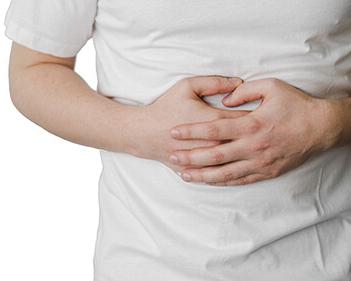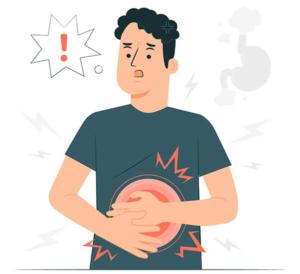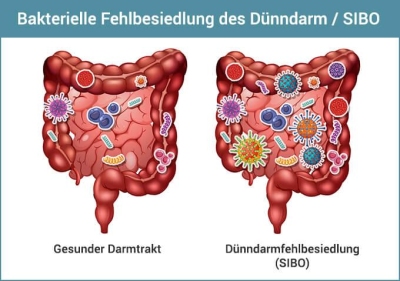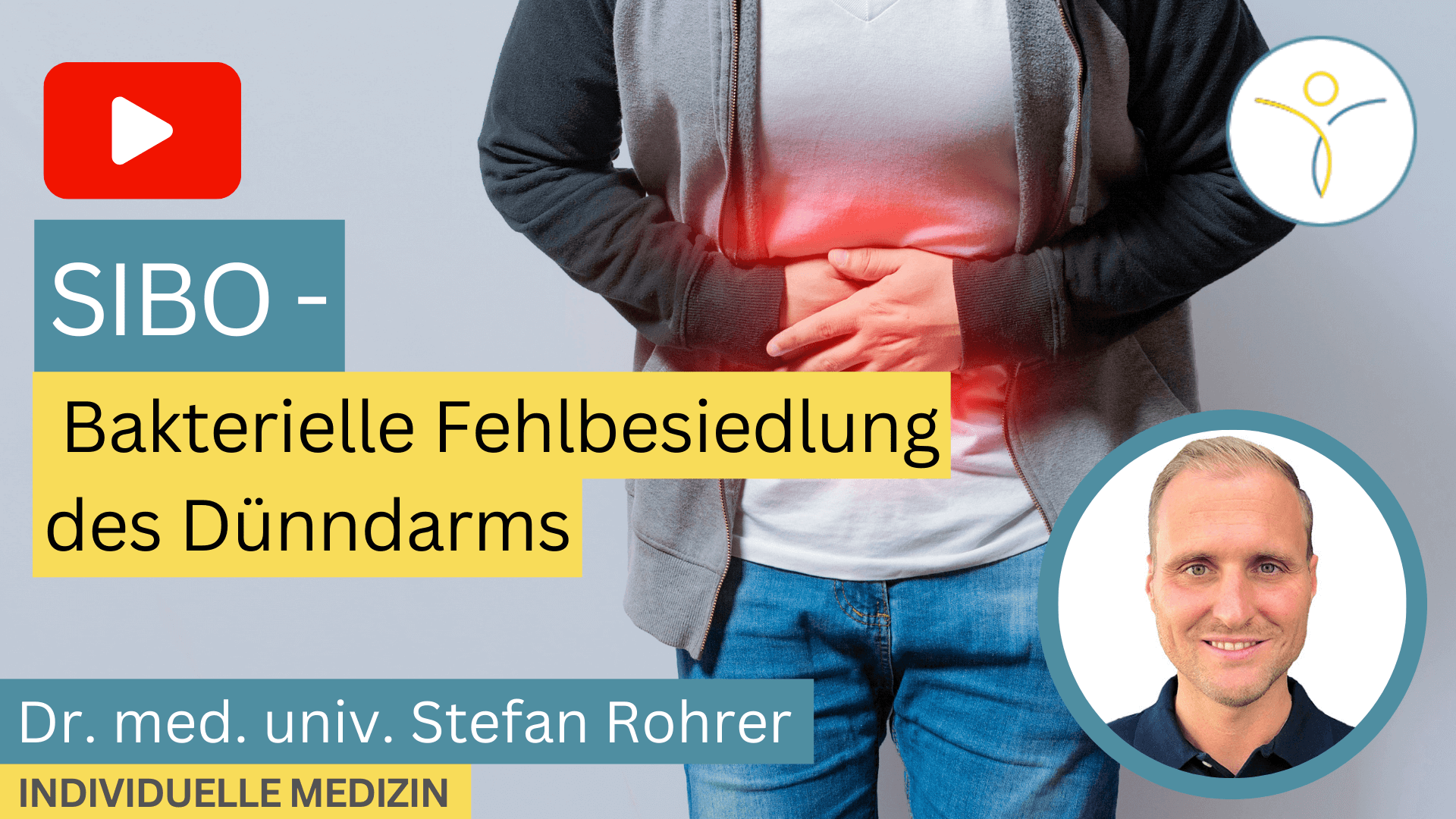SIBO - Small Intestinal Bacterial Overgrowth
Bacterial overgrowth in the small intestine (SIBO) is the most common cause of irritable bowel syndrome (IBS).
It is estimated that two-thirds of IBS patients suffer from undiagnosed SIBO. IBS is one of the most common diagnoses worldwide, and the trend is increasing.

SIBO often goes undiagnosed because the symptoms are not specific and other diseases in the digestive tract can cause similar symptoms. Another problem is that SIBO often overlaps with other conditions, which can complicate diagnosis. In addition, many physicians do not recognize SIBO as a disease in its own right and do not routinely perform the tests.
Update – New terms for the variants of gastrointestinal disorders
What is SIBO syndrome including H2S-SIBO, IMO syndrome, SIFO syndrome and SIMO syndrome?
SIBO stands for “Small Intestinal Bacterial Overgrowth” and IMO for “Intestinal Methanogen Overgrowth“.
A SIBO describes a condition in which the wrong bacteria are in the wrong place. Here the total bacterial count in the small intestine is increased. The small intestine is generally low in germs, while our large intestine is rich in germs. In the case of bacterial overgrowth in the small intestine, the small intestine becomes overgrown with bacteria. Those then utilize the food lying there and produce gases through fermentation, which can then lead to discomfort.
Hydrogen-type SIBO is usually associated with diarrhea and is diagnosed by a breath test. The gas that is made responsible for the complaints here is hydrogen.
A SIBO of the hydrogen sulphide type (H2S type) can currently only be determined by microbiome analysis. For this reason, an overgrowth of the hydrogen sulphide-forming intestinal flora causes problems. H2S in large quantities can directly damage the intestinal mucosa and also cause numerous problems away from the intestine and also damage the power plants of the cell, the mitochondria, and thus contribute to a lack of energy and fatigue.
In IMO syndrome, the large intestine is also affected. This leads to a growth of methane-forming bacteria (e.g. primordial bacteria/arachae etc.). Excessive methane is produced here, a gas which, among other things, makes the intestines sluggish and prolongs the stool transportation time. Those affected often complain of a pronounced tendency to constipation. Since 2020, this has been a separate clinical picture and has been separated from SIBO syndrome by the American College of Gastroenterology. Previously, the pathology behind an IMO was often referred to as methane-type SIBO. This is regularly associated with constipation.
In addition to these terms, there are also the terms SIFO. This stands for “Small Intestine Fungal Overgrowth“, i.e. an overgrowth of fungi in the small intestine.
And there is another rather rarely used term called SIMO. This stands for “Small Intestine Microbial Overgrowth“, i.e. an overgrowth of the small intestine by various microbial pathogens including parasites.
As you can see, the terminology is quite confusing and there are already indications of different causes of the complaints.
What is SIBO?
SIBO stands for “Small Intestinal Bacterial Overgrowth” and describes a condition in which excessive amounts of bacteria accumulate in the small intestine. Small intestinal malabsorption is a diagnosable and treatable disease. Early diagnosis and treatment of SIBO can help relieve symptoms and prevent complications.
SIBO symptoms
 Typical IBS symptoms as well as SIBO symptoms are abdominal pain, a bloated abdomen (often without flatulence), flatulence and irregular bowel movements, ranging from constipation (especially in methane-type SIBO) to diarrhea (especially in hydrogen-type SIBO), and which alternate regularly.
Typical IBS symptoms as well as SIBO symptoms are abdominal pain, a bloated abdomen (often without flatulence), flatulence and irregular bowel movements, ranging from constipation (especially in methane-type SIBO) to diarrhea (especially in hydrogen-type SIBO), and which alternate regularly.
Other SIBO symptoms include bad breath, a secondary fructose malabsorption, a secondary lactase deficiency (with resulting lactose intolerance), and a secondary diamine oxidase deficiency (with resulting histamine intolerance > also see MCAS). Secondary means, that after successful treatment there is usually a significant improvement of these symptoms, sometimes even a complete remission (= disappearance). Often there is also an association with a leaky gut syndrome (= >more information about Leaky Gut Syndrome) or a disturbed utilization and absorption of nutrients via the small intestine (malassimilation).
Clinical experience shows that many patients often have those symtoms for countless years. Conventional therapy recommendations such as psychotherapy, the sole administration of pre- or probiotics, intestinal cures or intestinal cleansing, advice to eat more or less fiber, whole foods, etc. do not work if the underlying cause is not treated. The SIBO does not disappear with these measures, or keeps coming back.
For more detailed information on symptoms, also read our article SIBO Symptoms.
SIBO Definition
Small intestinal bacterial overgrowth (SIBO) occurs when there is an abnormal increase in the overall bacterial population in the small intestine, and, at the same time, particularly types of bacteria which are commonly found only in the large intestine. In short, with a SIBO there are too many bacteria in the wrong place.
These “misdirected” bacteria utilize the food that has not yet been absorbed and completely broken down by bacterial fermentation. The breakdown produces gases, osmotically active substances and toxic breakdown products.

SIBO Video:
Causes of SIBO
In the context of a SIBO, colon germs overgrow the normally germ-poor small intestine.
One cause can be a “leaky” ileocecal valve (ICV), e.g. after surgery, e.g. in chronic inflammatory bowel disease or after tumors or intestinal adhesions. The IC valve separates the large and small intestine.
A lack of gastric acid can favor the development of a SIBO. This is also the case if one takes proton pump inhibitors, e.g. Pantoprazole, for a longer period of time. This causes undigested food residues (proteins) to enter the small intestine, where fermentation by the intestinal flora takes place causing gas development. Overall, a digestive enzyme deficiency promotes the development of SIBO (e.g., exocrine pancreatic insufficiency or bile stasis from a naturopathic point of view).
Lactose intolerance and fructose malabsorption can also lead to SIBO, and SIBO can lead to secondary (reversible) lactose intolerance and fructose malabsorption.
Other causes are heavy metals (e.g. mercury) which negatively affect the intestinal flora, chemicals and pesticides (e.g. glyphosate), high percentage alcohol or antibiotic intake. In the case of antibiotic intake, one must differentiate. They basically have negative effects on the intestinal flora. With regard to the development of SIBO, it is important to know that antibiotics, which primarily reduce the aerobic flora (small intestine flora) and not the anaerobic flora, massively promote the development of SIBO (e.g. cotrimoxazole, tetracycline, ofloxacin).
Other causes are peristaltic disturbances. These also occur in the context of a parasitic intestinal disease, the Lambliasis (=> more information about Lambliasis), or after a Campylobacter jejuni infection. Campylobacter jejuni produces toxins that affect the nervous system of the intestinal wall (intramural nervous system) and can also cause long-term disturbances. Furthermore, peristaltic disorders occur in diabetics, in patients with scleroderma or amyloidosis.
SIBO Diagnostics
The intestinal flora analysis or microbiome analysis is not suitable for a reliable diagnosis of SIBO. At best, it can provide clues.
The best solution are breath tests (=> also see H2-breath tests). The vast majority of bacterial overgrowth can be diagnosed with the help of a hydrogen breath test (personal experience: more than 90-95%). In very rare cases, there is an isolated bacterial overgrowth caused by methane-forming germs, especially Methanobrevibacter. These can then only be diagnosed by means of a methane breath test.
Hydrogen breath tests include breath tests with lactulose for the detection of bacterial overgrowth in the middle and lower small intestine and with glucose for the detection of bacterial overgrowth in the upper small intestine. For diagnosis, symptoms during the breath test and the corresponding breath test result must always be present at the same time.
SIBO Therapy
Primarily, the causes should be eliminated and, if necessary, further diagnostics should be performed.
This includes, among other things, an examination of the intestinal flora and functional parameters (calprotectin, alpha 1antitrypsin, zonulin, EPX, sIgA, etc.). The clarification of celiac disease, histamine intolerance and food allergies are some examples, which must also be clarified before treatment, since no success can be achieved in the treatment if these clinical pictures are not known and observed. A clarification of the vitamin and mineral stores is also recommended.
Furthermore, the large intestine flora must be reduced and eliminated from the small intestine. The small intestinal flora must be rebuilt. Diet is immensely important.
Slow eating is recommended, each bite should be chewed at least 30 times. Whole grain foods should be avoided, as those benefit the colon germs and their expansion. Foods with a high polyol and galactan content should be avoided. Carbohydrate reduction and a low FODMAP diet are very important. A probationary renunciation of dairy products of any kind, gluten and especially wheat due to the high ATI content (amylase trypsin inhibitors) and eggs (so-called autoimmune protocol) can be tried. If a leaky gut syndrome is present, this is mandatory.
Please also read: SIBO diet plan – there you will also find a free SIBO food list / FODMAP list for download.
A manual therapy, especially the visceral osteopathy (extremely important), neural therapeutic applications, rubs with oils and acupuncture have a supporting positive effect.
The total duration of all phases of the therapy is 6 to 9 months.


